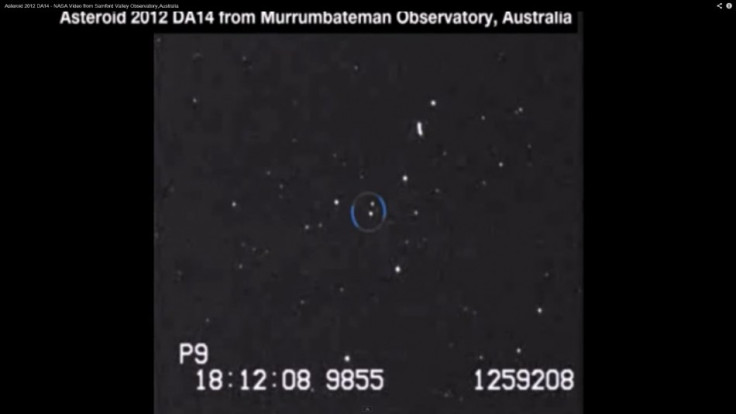Scientists Warn of Danger as 2012 DA14 Asteroid Misses Earth [VIDEO]

An asteroid as big as a multi-storey building gave the Earth its closest recorded encounter with an object of that size on 15 February, prompting scientists to warn of the danger of future impacts.
The 2012 DA14 asteroid passed closer than the orbital range of some telecoms satellites as it came within 17,200 miles (27,700 km) of Earth.
At 150 feet long, the body was travelling at 17,450 miles per hour (28,100 kph), and came closest to the Earth at about 19.25 GMT.
It was visible through binoculars or a telescope for people in dark regions.
The asteroid arrived shortly after a meteor caused approximately 1,000 injuries in the Russian Chelyabinsk region on Friday (15 February), though experts say the two events were unrelated, with Professor Simon Fitzsimmons of the University of Belfast describing it to the BBC as a "cosmic coincidence".
Scientists believe that if 2012 DA14 had hit Earth, the explosion would have been equivalent to about 2.4 million tons of explosives, or 180 times the force of the atomic bomb that was dropped on Hiroshima.
Scientists have warned that more needs to be done to prevent a similar asteroid striking our planet.
"This close approach could just as easily have been an impact," Dan Durda, of the Southwest Research Institute in Boulder, Colorado, wrote in a blog post on Wednesday 13 February.
"With many tens of thousands of undiscovered objects this size roaming our neighbourhood, it's only a matter of time before one of them booms through our atmosphere rather than skating through our planet-circling constellation of satellites," he said.
Nasa scientists have identified and mapped the course of 90 percent of asteroids near the Earth whose dimensions - in excess of 0.6 miles (1km) - would cause cataclysmic damage if they struck the planet, and none is on a collision course with us.
However, drawing on data from Nasa's WISE telescope, they believe they have spotted just 30 percent of asteroids 330 feet (100m) or larger, which have the capacity to wipe out an area the size of a US state.
Furthermore, they believe that they have spotted just 1 per cent of asteroids the size of 2012 DA14 or bigger.
Writing in the New York Times, NASA expert Donald Yeomans said: "Earth runs its course around the sun in a cosmic shooting gallery - with us as the target."
In 1908, in 'The Tugunska Event', an asteroid which measured an estimated 130 feet or 40 metres exploded over Siberia, levelling 825 square miles (2,137 sq km) of forest.
A larger asteroid hit the Earth 65 million years ago, wiping out the dinosaurs and most other known vertebrates.
"It is actually difficult to look for these things," Paul Dimotakis of Caltech in Pasadena told Space.com.
He said that the glare from the sun often makes it difficult for scientists to spot asteroids near the Earth, and that telescopes view more distant asteroids more clearly.
"It's like the man who lost the keys and is looking where there is light, not where the keys were lost," he said.
"Rather than playing the odds of time, wouldn't it be far better to be able to know, with some reasonable certainty, that we've catalogued the entire population of potentially hazardous asteroids?" Durda wrote.
Researchers at the B612 Foundation, where he serves on the board of directors, plan to launch a satellite in 2017 that would settle in to Venus' orbit, allowing it to avoid the sun's glare and spot dangerous giant asteroids potentially decades before they hit Earth.
This would enable experts to launch missions like the spacecraft that was slammed into the comet Tempel-1 in 2005.
Travelling more slowly than the Earth, the 2012 DA14 asteroid orbits the sun over 368 days a year, but on a different trajectory.
Last night it approached the Earth from the south, before soaring back towards the sun.
It passed closest to the Indian Ocean, and was most clearly visible from Asia, Australia, and eastern Europe.
Professional and amateur astronomers rigged up live internet feeds of the asteroid passing, making the event visible to sky gazers worldwide.
2012 DA14 was first spotted by astronomers in Spain when it last passed the Earth in February 2012, and they were able to work out its past and future trajectory from information they gleaned, and predict last night's fly past.
Professor Fitzsimmons said: "When asteroids come this close, it's very important to try to learn about them - it's become so bright, so it's so easy to study."
"We get an additional insight into these small objects, which are the most likely impactors on Earth."
© Copyright IBTimes 2025. All rights reserved.




















